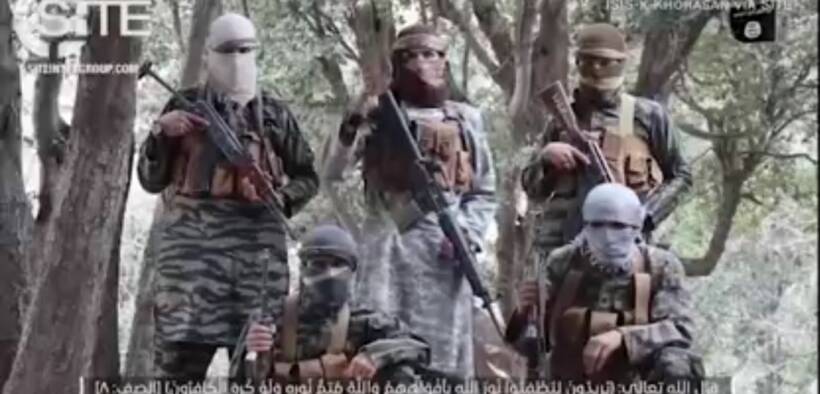Did the US Support the Growth of ISIS-K in Afghanistan?

Regional players have long accused the US of supporting the group with midnight helicopter transport into Afghanistan.
(By: Alex Rubinstein, Substack) The list of governments, former government officials, and organizations in the region that have accused the US of supporting ISIS-K is expansive and includes the Russian government, the Iranian government, Syrian government media, Hezbollah, an Iraqi state-sponsored military outfit and even former Afghan President Hamid Karzai, who called the group a “tool” of the United States as journalist Ben Norton recently noted, characterizing Karzai as “a former US puppet who later turned against the US, and knows many of its secrets.”
So what exactly is ISIS-K and what is it’s history? After ISIS’s Afghanistan variant became a household name overnight following a suicide bombing at Kabul’s airport that killed more than 170 people and wounded more than 200, the group’s history demands renewed scrutiny.
Back in May, I tweeted that “I must not be the only one expecting a so-called ‘rise of ISIS’ in Afghanistan in the near future…”
I wrote this because mass-casualty terrorist attacks are repeatedly used as justification by the United States for continuing its occupations of foreign countries: the “counterterrorism mission,” or the “terrorist threat.” And it has been a long time since the Taliban has taken credit for any such acts.
In fact, all the way back in August 2016 — a little over five years ago — Taliban spokesman Zabihullah Mujahid told Iranian media that “In cooperation with the nation, [the Taliban] has prevented the terrorist group from gaining a foothold in Afghanistan.”
Whoops pic.twitter.com/uOxOysjO4w
— Alex Rubinstein (@RealAlexRubi) August 28, 2021
The strongest argument in favor of a US withdrawal put forward by the Biden Administration is that the United States completed its counter-terrorism mission in Afghanistan. The attack by “ISIS-K” on the Kabul airport collapses this argument, and so it benefits those who would prefer to see Afghanistan permanently occupied by the US.
It’s also not the actions of a calculating terrorist group: why commit mass violence at such a critical juncture? Why do it when all eyes are on Afghanistan and many in the Pentagon, in NATO, are looking for any excuse to invade again?
CNN’s Clarissa Ward was even able to interview a “senior ISIS-K commander” two weeks before the attack who made these points. The “commander” told CNN that the group was “lying low and waiting for its moment to strike.”
While the US-backed government was still in power in Kabul, the ISIS-K “commander” told Ward that “it’s no problem for him to get through checkpoints and come right into the capital.” He even let the CNN crew film his entrance into the city.
In the absurd interview, CNN sat in a hotel room with the supposed ISIS-K leader and protected his identity. Ward asked him comically upfront questions like “are you interested, ultimately, in carrying out international attacks?”

Screenshot from CNN’s interview.
In response to a question about their plans for expansion in Afghanistan following a US withdrawal, the “commander” said “instead of currently operating, we have turned to recruiting only, to utilize the opportunity and to do our recruitment. But when the foreigners and people of the world leave Afghanistan, we can restart our operations.”
What changed?
This is not to say definitively that the ISIS-K attack was a false flag, but there are many holes in the narrative that demand scrutiny. It is worth noting here that the US is in charge of security at the airport until August 31, while the Taliban controls the surrounding area.
Moreover, the United States had advanced knowledge of the attack. “Because of security threats outside the gates of Kabul airport, we are advising US citizens to avoid traveling to the airport and to avoid airport gates at this time,” read an August 25 security alert on the US Embassy in Afghanistan website. “US citizens who are at the Abbey Gate, East Gate, or North Gate now should leave immediately.”
Britain and Australia issued similar warnings of a “high threat of a terrorist attack” and a “very high threat of a terrorist attack” respectively.
The following day, a suicide bomber blew himself up and killed scores of people. Additionally, US forces reportedly gunned down a large number of people as well. “Many we spoke to, including eyewitnesses, said significant numbers of those killed were shot dead by US forces in the panic after the blast,” tweeted BBC correspondent Secunder Kermani, who reported from the area.
The very next day after the attack, the United State Central Command announced that “US military forces conducted an over-the-horizon counterterrorism operation today against an ISIS-K planner. The unmanned airstrike occurred in the Nangarhar Province of Afghanistan.”
In short, the US knew an attack was coming, the attack happened, and then within 24 hours the US announced that they killed the perpetrator, saying “initial indications are that we killed the target.”
NYT Live Update from 40mins ago: following the failure to act on intelligence and prevent ‘ISIS-K’ from carrying out a suicide bombing that the US had advanced knowledge of, US forces in Afghanistan are conducting “controlled demolitions” in CIA bases in the country ? pic.twitter.com/B37fHB67bh
— Alex Rubinstein (@RealAlexRubi) August 28, 2021
Then on Saturday, US forces demolished a CIA base in the country.
These facts give us more questions than answers. Why was the US unable to prevent the attack? Giving the military and intelligence community the benefit of doubt that they didn’t know who was going to attack and therefore could not have prevented it, how did they figure it out so quickly after the attack? If it was the CIA, which is more than likely, who provided this information, why is the military destroying CIA infrastructure that could plausibly play a role in helping to figure such things out? This is an especially troubling question considering that less than a few hours before the New York Times reported that US troops destroyed a CIA base, President Biden said that military commanders informed him that another attack on the airport is “highly likely” in the next 24-26 hours.
Long Running Accusations of Support
Researcher and commentator Hadi Nasrallah noted on Friday that the leader of the Middle East resistance group Hezbollah “said that the US have been using helicopters to save ISIS terrorists from complete annihilation in Iraq and transporting them to Afghanistan to keep them as insurgents in Central Asia against Russia, China and Iran.”
Hezbollah is not the first player in the area to make the accusation of the US setting up a ratline via helicopter flights to Afghanistan for ISIS: Russia and Iran, which borders Afghanistan, have been for some time.
As Hadi Nasrallah noted, Syra and Iraq have said more or less the same, with Syrian state media SANA saying in 2017 reporting that “US helicopters transported between 40 and 75 ISIS militants from Hasakah, North Syria to an ‘unknown area.’”
In 2017 and 2020, Syria’s SANA reported that that US helicopters transported between 40 and 75 ISIS militants from Hasakah, North Syria to an “unknown area”. The same thing was reported for years in Iraq by the PMU along with reports that US helicopters dropped aid for ISIS.
— Hadi Nasrallah (@HadiNasrallah) August 28, 2021
As Hadi Nasrallah pointed out, “the same thing was reported for years in Iraq by the [Iraqi Popular Mobilization Forces] along with reports that US helicopters dropped aid for ISIS.”
Back in 2017 and 2018, Iranian and Russian officials had questions of their own. Chief of Iranian General Staff Major General Mohammad Hossein Baqeri accused the US of “relocating members of the Daesh (ISIS or ISIL) terrorist group to Afghanistan after their defeats in Iraq and Syria” in early February of 2018.
“The Americans point to (the existence) of tensions in the southwest Asia region as an excuse for their presence in the region,” Major General Baqeri told reporters.
The following month, Mohammad Javad Zarif, the longtime foreign minister of Iran who departed from the post earlier this year, said “we see intelligence, as well as eyewitness accounts, that Daesh fighters, terrorists, were airlifted from battle zones, rescued from battle zones, including recently from the prison of Haska [Meyna].”
Iran and Russia have “consistently allege[d]” that unmarked helicopters were flying into regions of Afghanistan where ISIS had a foothold. But as Javad Zarif pointed out in March 2018, “this time, it wasn’t unmarked helicopters. They were American helicopters, taking Daesh out of Haska prison. Where did they take them? Now, we don’t know where they took them, but we see the outcome. We see more and more violence in Pakistan, more and more violence in Afghanistan, taking a sectarian flavor.”
As the US government propaganda outlet Voice of America wrote at the time in 2018, “the terrorist group uses Nangarhar as its main base to launch attacks elsewhere in Afghanistan.” This is the same province the US struck with an unmanned drone the day following the attack on the airport.
As Voice of America noted, the National Security Advisor of the recently-collapsed Afghanistan government offered Russian and Iranian delegates “joint investigations into allegations of unmarked helicopters flying IS[IS] fighters to battle zones in the country.”
In February 2018, Russian Foreign Minister Sergei Lavrov implored the US to answer the question.
“We still expecting from our American colleagues an answer to the repeatedly raised questions, questions that arose on the basis of public statements made by the leaders of some Afghan provinces, that unidentified helicopters, most likely helicopters to which NATO in one way or another is related, fly to the areas where the insurgents are based, and no one has been able to explain the reasons for these flights yet,” Lavrov said. “In general [the United States] tries to avoid answers to these legitimate questions.”
Later that month, Lavrov had more to say on the issue: “According to our data, the IS[IS] presence in northern and eastern Afghanistan is rather serious. There are already thousands of gunmen.”
“We are alarmed as, unfortunately, the US and NATO military in Afghanistan makes every effort to silence and deny [ISIS’s presence in Afghanistan],” he added.
These mysterious dead-of-night helicopter flights even raised the eyebrows of the fallen US puppet government. All the way back in May 2017, a local official in the Sar-e-Pul province said two military helicopters landed in the dead of night.
“According to the report we have received from the 2nd Battalion of the Afghan National Army, which fights on the first line of the battle in Sar-e-Pul, two military helicopters landed in a stronghold of the enemy at 8pm last Thursday,” Mohammad Zahir Wahdat, the governor of the province, told Afghan media.
Following Lavrov’s comments in 2018, General John Nicholson, the commander of NATO’s mission in Afghanistan, said that Russia was exaggerating the threat of ISIS in Afghanistan. “We see a narrative that’s being used that grossly exaggerates the number of Isis [Islamic State group] fighters here,” Gen. Nicholson told the BBC. “This narrative then is used as a justification for the Russians to legitimize the actions of the Taliban.
This talking point was reinforced by Navy Captain Tom Gresbeck, the public affairs director of NATO’s Afghanistan mission, who said that US forces have “no evidence of any significant migration of IS-K foreign fighters. We see local fighters who switch allegiances to join ISIS for various reasons, but the Russian narrative grossly exaggerates the numbers of ISIS fighters that are in the country.”
It appears that this week, the United States may be forced to eat its words.
Did you enjoy reading this article? I value the free exchange of information, so I don’t put anything behind a paywall. Consider kicking me a few bucks on PayPal to support my independent reporting or becoming a patron.
Alex Rubinstein is an independent reporter on Substack. You can subscribe to get free articles from him delivered to your inbox here, and if you want to support his journalism, which is never put behind a paywall, you can give a one-time donation to him through PayPal here or sustain his reporting through Patreon here.













